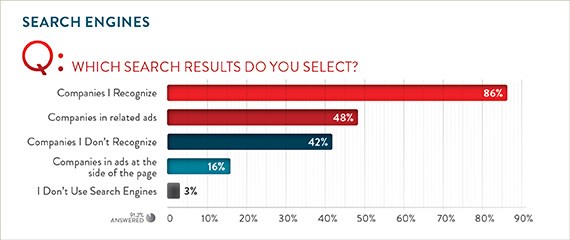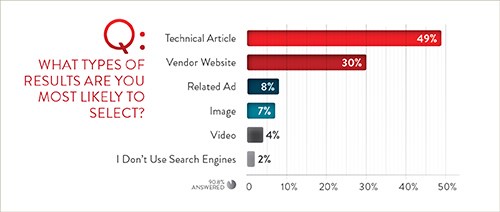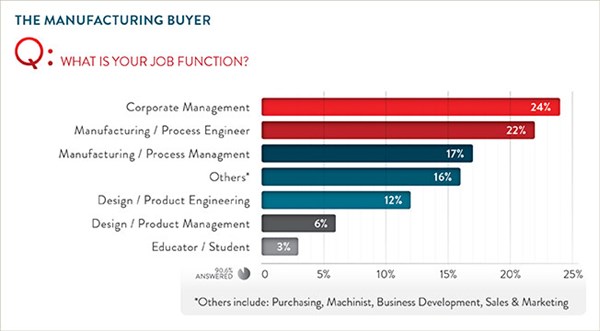Gardner’s Media Usage in Manufacturing 2014 – Part 2 Insights: Buying Cycle and Vendor Selection
It’s said knowledge is power . . . never truer than in the “Information Age.” This is part 2 of a 6 part series of articles, discussing the findings of Gardner Business Media’s research study, Media Usage in Manufacturing 2014 and what they might mean to the B2B marketer.
By Mark Semmelmayer
Chief Idea Officer
Pen & Inc. Marketing Communications

This is part 2 of a 6 part series, discussing Gardner Business Media’s research study, Media Usage in Manufacturing 2014. In this series, I’ll endeavor to break down the findings of the study, and their implications for the B2B marketer, into bite sized chunks. Download the report here
This post explores their findings on purchase cycles and vendor selection influences. We need to know how customers behave before we can hope to influence that behavior.
1) Customers are information power users
B2B buyers are hungry for information . . . the right kind of information . . . to help them do their job. Gardner’s research indicates that more than 70% of respondents look for information on industry best practices, products and services daily or weekly.
This part of the buying process belongs to the buyer, where PULL MEDIA becomes most important. PULL includes industry and supplier websites, search engines, webinars and blogs. We’ll address search results a bit later, but among these broad categories, buyers rate the most influential as (combined primary and secondary rank percentage):
- Industry websites – 93%
- Company websites – 93%
- Industry Forums – 56%
- Webinars – 40%
- Social Networks – 29%
- Blogs – 25%

Marketing Implications: If you don’t have a strong digital marketing team/presence, build one, NOW. Concentrate, first, on contributing information and expertise to industry-specific websites, repurpose for your own website, and repurpose yet again for industry forums, as appropriate. Consider conducting, or sponsoring webinars. Today’s software and webinar vendors make this very attainable. Yes, you need to look at how social media and blogs have impact, but evidence says that’s not Job #1.
2) I’ve been searching . . .
B2B customers are technically savvy . . . and looking to get smarter. A technically-minded buyer trusts technical content and expert commentary. It doesn’t matter if you’re selling the latest in laser tooling gear or infection control products for healthcare; factual, technical information that demonstrates your credibility as a source is key.
No doubt, search engine results are a major driver in creating buyer interest in a particular vendor. As for the search results they select:
- Companies they recognize – 86%
- Company with related advertising – 48%
- Companies not recognized – 42%
- Companies with ads on search page – 16%
- Don’t use search engines – 3%
In terms of the content they desire and consume from search results:
- Technical Article– 49%
- Vendor Website– 30%
- Related Ad– 8%
- Image– 8%
- Video – 7%
- Don’t use search engines – 2%

Marketing Implications: Beyond finding that 3% who don’t use search engines, just to ensure the oil lamps in their offices aren’t fire hazards, it looks like your search strategy and its maintenance is a fundamental job of your digital team. But, that function needs integration with your broader marketing communications strategy. This is the first research finding which indicates PUSH MEDIA has an impact on digital results. If companies they recognize (branding) and companies with related ads (marcomm spend) are the top drivers in viewed results, the conclusion is self-evident. Also important: ads on search pages (paid search), create marginal impact at best. This tells us organic search results, the end-point of search engine optimization (SEO) and other search tactics, can’t be understated. And, since search engine algorithms change at times, a digital team that can follow and react to those changes is critical.
3) It’s what you know . . .and who you know
The B2B buyer tends to be more of a committee than an individual. From Gardner’s finding, your customer is a member of senior management, part of a team of three or more impacting purchasing decisions. He/they looks/look for products and services at least once a week and values brand reputation when making research and vendor selection/purchasing decisions. While job titles in your market may vary, this still holds true. In manufacturing, buyer/influencer titles are:
- Corporate Management - 24%
- Manufacturing Engineer - 22%
- Manufacturing Management - 17%
- Others* - 16%
- Product design/ engineering - 12%
* Includes: Purchasing, Machinist, Business Development, Sales and Marketing
Ranking highest to lowest, in terms of factors impacting vendors considered in a purchase decision, the considerations are: Technology, Reputation, Existing Vendor Relationship, Service, Cost and Risk Analysis.
Ranked highest to lowest, in terms of influential factors in developing a perception of a vendor are: Peers/Colleagues, Editorial Coverage/Technical Articles, Sales and Marketing Efforts, Participation in Industry Events and Search Engine Returns.

Marketing Implications: Some basics in marketing don’t change . . . and never will. Knowing your audience, and putting meaningful information in front of them, gets your foot in the door and an invitation to put a bid on the table. Management wants good results at a good price. Engineering and manufacturing management want reliability, efficient throughput and technical specificity. Your marketing and communications efforts need to be an octopus, with tentacles that touch all these constituencies. Think Integrated Marketing Communications (IMC).
If you boil this down, it’s clear your reputation as a vendor is the linchpin. If they know you, you have a good reputation, good “props” from peers and are seen as a technical leader, you get a bid request. You’ve got to be solid . . . top to bottom . . . in terms of product quality and marketing presence, to get the buyers time of day. That’s a strong argument for having a marketing seat at the C-suite table, on par with manufacturing, product development and sales.
4) A consolidated take-away
This research makes it clear. Brand is a primary influence on where and at whom buyers look to for a solution to their needs. Clearly, this study targeted the industrial buyer (that’s Gardner’s target), but, with limited mental gymnastics, you can adapt it to any market and buyer. While the world is changing, marcomm-wise, it appears that creating and/or maintaining your brand, in the B2B space, is still a multi-faceted discipline.
The next posts in this series will explore Gardner’s finding regarding both traditional and “new” PUSH MEDIA channels and what those findings mean to B2B communications effectiveness.
Need more information?
Mark Semmelmayer
Chief Idea Officer
Pen & Inc. Marketing Communications
Marietta, GA
770-354-4737
LinkedIn


